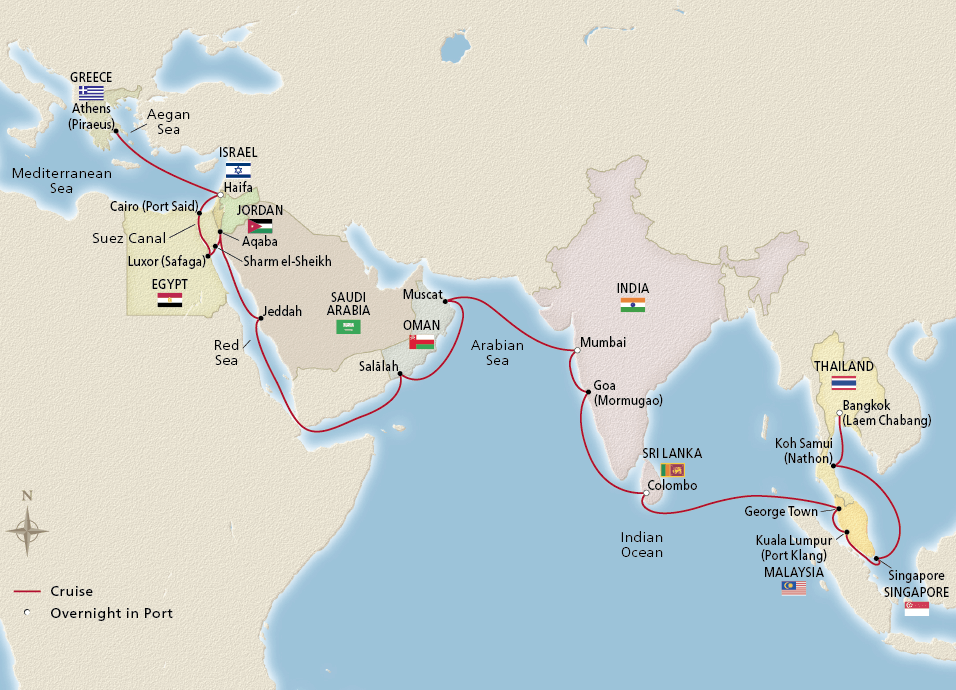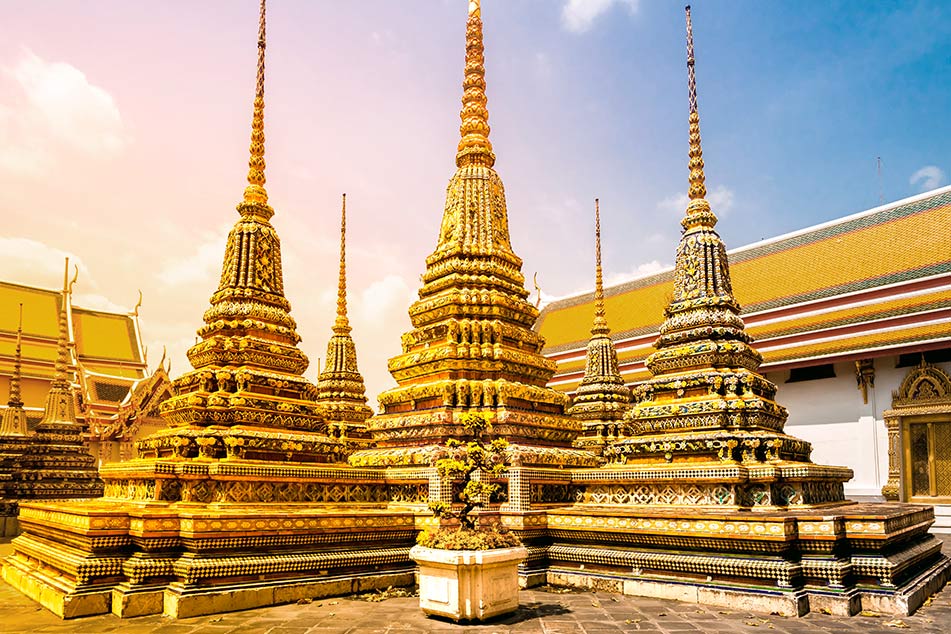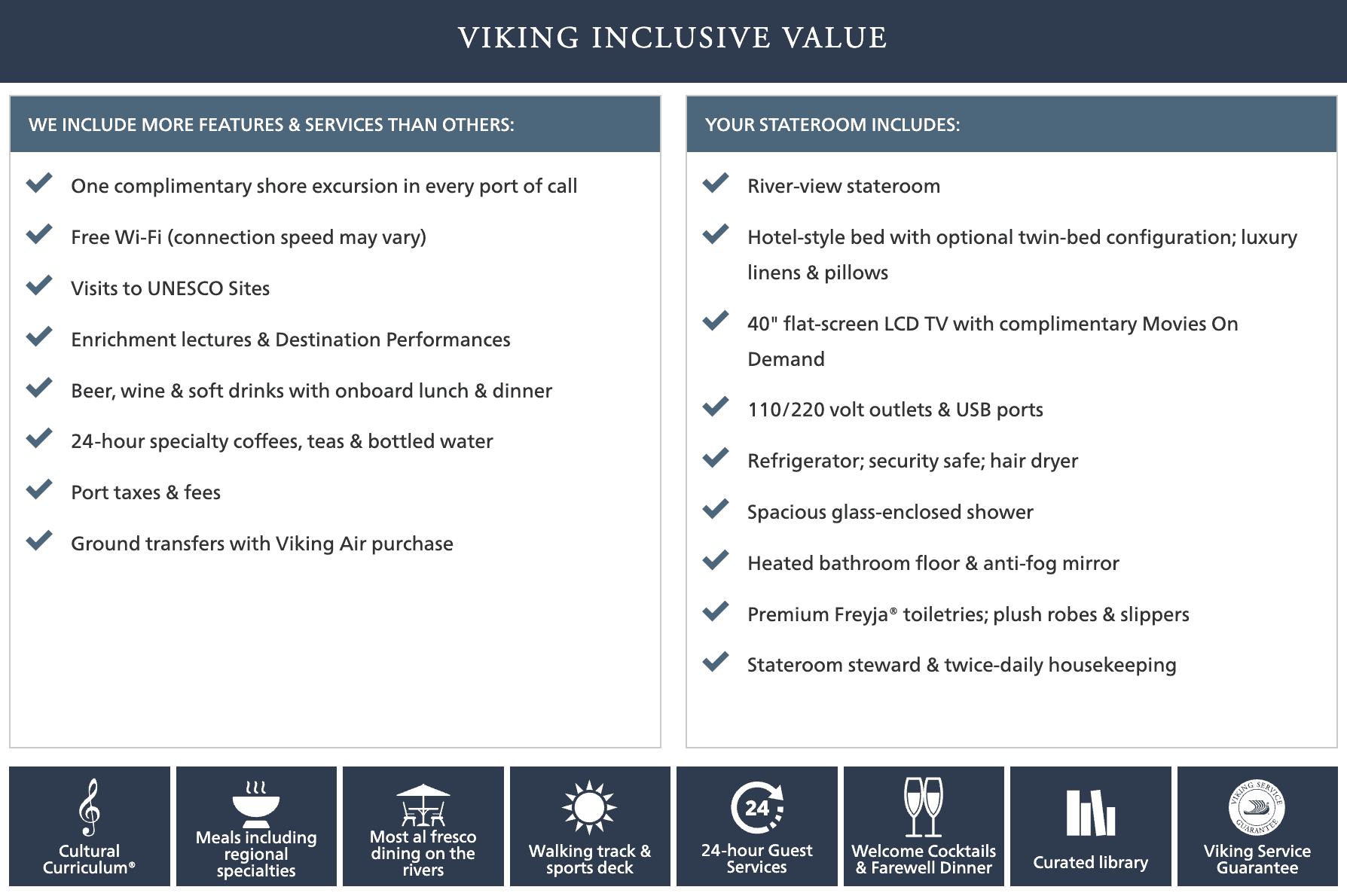Call us or email us if you have any questions.

Sail in a great explorer’s wake
Trace the great Spice Routes that inspired Marco Polo himself during a 36-day voyage into the heart of the Mediterranean and Asia. Follow in the wake of ancient merchant travelers, crossing the Suez Canal to discover the regions’ best-loved ports in the Levant, the Indian subcontinent and Southeast Asia. Enriching overnights in Haifa, Mumbai, Colombo and Bangkok help you truly connect with this intriguing part of the world.

Athens, Greece / Bangkok, Thailand
2024 Sailings on October
2025 Sailings on March
* Please check with us for dates & pricing
Cruise fare from $19,499.0 per person
* Please check with us for dates & pricing

Embark your ship and settle into your stateroom. Athens has been called the “birthplace of democracy.” Its legacy looms large from atop Acropolis Hill, the pinnacle of ancient Greece. This open air museum is an astonishing repository of once-mighty structures. From its colonnaded Parthenon—more than 2,600 years ago—revered Greek philosophers like Plato and Aristotle formulated new ideas of government and debated its role in civic life to captivated audiences. Remnants of spiritual life are also here in the several temples to Athena and Zeus.
Sail along one of the world’s most beautiful coastlines, known for its azure waters and picturesque islands. As you sail today, attend an informative lecture or watch a film in our state-of-the-art theater. A range of insightful TED Talks and destination-inspired seminars are offered daily.
Haifa is one of Israel’s most important and beautiful cities, built on the slopes of Mount Carmel and overlooking the Mediterranean Sea. Pilgrims of the Bahá’í faith flock here to visit the Hanging Gardens of Haifa, a series of breathtaking terraces on the hillside. Mount Carmel also holds significance to Jewish, Christian and Islamic faiths. Most notably, this was the spot of Elijah’s sacrifice by fire by which he miraculously ended a drought. Nearby, the ancient city of Acre, one of the oldest continuously inhabited cities in the world, is a UNESCO World Heritage Site.
High above Haifa, brilliant blooms spill down the side of Mount Carmel, a site significant in Judaism, Christianity and Islam. This place is also meaningful to those of the Bahá’í faith, who travel here from afar to see the Hanging Gardens of Haifa. The beautifully landscaped swath of flowers and topiary, arranged around wide, elegant mountainside stairways and plazas, creates stunning geometric designs. From Mount Carmel’s tabletop summit, visitors take in the breathtaking terraced gardens against the expansive backdrop of the city below and the Mediterranean beyond.
It has been said of Egypt’s exhilarating capital, “He who has not seen Cairo has not seen the world.” Certainly, the heart of the nation beats with an unbridled passion in this city made prosperous over millennia as a stopover for Sahara caravans on trade routes to Byzantium. Amid the stimulating strum, the insistent beauty of everyday life reigns here, with the serene Nile sliding through like an entrancing serpent. Cairo’s very age mesmerizes; its monuments have stood here for more than 5,000 years.
An engineering marvel, the Suez Canal was completed in 1869. The sea-level, single-lane waterway has no locks, and only two lakes allow north- and southbound ships to pass each other: Ballah Bypass and Great Bitter Lake. Along this historic waterway, stark desert sands stretch into Egypt and an occasional giant mound of sand appears on its banks, dug from the canal. Small patches of swaying palms are fed by canal waters. Nearby lies the town of Ismailia, known as the “City of Beauty and Enchantment,” which was built to serve the canal’s construction and maintenance.
Luxor is set on the east bank of the Nile River and once served as the capital of Egypt’s New Kingdom. Today, it is a UNESCO World Heritage Site lined with beautiful colonial hotels and some of the world’s most ancient and significant ruins. Many consider this city, watched over by graceful single-sailed feluccas plying the Nile, one of the world’s great open air museums. The sprawling Temples of Luxor and Karnak on the east bank are linked by the ancient Avenue of the Sphinxes. On the west bank, in the Valley of the Kings, lie the tombs of Egypt’s great pharaohs.
Egypt’s seaside resort of Sharm el-Sheikh is often called the “City of Peace” for the number of international peace conferences held here. Its location, where major bodies of water meet, has transformed from a modest fishing village into a major port. However, “Sharm,” as it known by locals, is renowned for its unrivaled scuba diving among vibrant coral, dramatic rock formations and reef walls. The surrounding desert, too, though less colorful, exudes its own stark beauty. A Jeep safari is the ideal way to explore beyond the scenic jagged mountains that hug the town.
Jordan’s only coastal city, Aqaba is set amid coffee-colored desert hills. With its central location between Africa and Asia, it has played a significant role in the region’s trade for thousands of years. Today, its prosperity rests in its position as the sole port of the nation and in its pristine dive sites. The city’s history, too, draws inquisitive travelers. In 1917, T. E. Lawrence (known as Lawrence of Arabia) led troops here in the Battle of Aqaba. The white-robed English ally helped the Arabs run the Turks from the city’s fortress during a camel charge.
Follow in the wake of early explorers who sailed the waters of the Red Sea as long ago as 2500 BC. History and legend are rich in this narrow stretch of sea between Asia and Africa. Enjoy the amenities of your ship as you sail. Perhaps take a breath of fresh air on a brisk walk around the Promenade Deck or begin your day with a workout in the well-equipped Fitness Center.
Saudi Arabia’s second-largest city, Jeddah has played a dual role throughout its history. Located on the eastern shores of the Red Sea, it was a major port for Indian Ocean trade routes starting in the seventh century. It also became a historically important gateway for Muslim pilgrims arriving by sea on their journey to the holy cities of Mecca and Medina—a role that continues to this day. A modern multicultural city, Jeddah’s heritage can still be experienced in the distinctive architecture and bustling souks of its historic Old Town, a UNESCO World Heritage Site.
Trace the coastlines of Africa and Saudi Arabia as you sail the Red Sea, one of the world’s most legendary seaways. Moses is said to have parted its waters and Egyptian Queen Hatshepsut led trade missions here on ancient vessels. Renew your body, mind and spirit in our Scandinavian-inspired spa, a Nordic sanctuary of holistic wellness, today while at sea. Whether you unwind in the Sauna, refresh in the Snow Grotto or take a dip in the Thermal Pool, you will feel recharged and revitalized.
Follow the centuries-old trade route linking the Red Sea to the Arabian Sea. This historic waterway was named for the former British Crown Colony city of Aden, an adjacent port in today’s Yemen. As you sail, explore our well-curated library, tucked in a private alcove of The Living Room, and select from a broad range of titles. Read a book by the Main Pool, a calming oasis in any weather with its retractable roof, allowing for year-round swimming.
The Omani city of Salālah is situated on the southeastern edge of the Arabian peninsula and was a major port on the 13th-century frankincense route. This fascinating cultural history was supported by several sites around the city, such as ancient towns and caravan oases, some of which are UNESCO World Heritage Sites today. Salālah is often called the “Garden City” for the greenery and coconut trees that line its streets and boulevards. One of its most impressive sites is the Sultan Qaboos Grand Mosque, with its richly adorned Islamic architecture.
Cross the Arabian Sea, originally called the Erythraean Sea, after King Erythras of Greek mythology. Its modern-day moniker derives from the Arab sailors who dominated trade on its waters from the 9th century onward. As you sail, take advantage of the array of delicious cuisine offered on board. You may visit Mamsen’s, our casual gourmet deli, any time from early morning to late at night for a taste of traditional Norwegian fare. Or, dine at Manfredi’s Italian Restaurant for authentic fare with options ranging from Milanese risotto to Tuscan-inspired classics.
Muscat enjoys a stunning setting between the Arabian Sea and the rocky Western Al Hajar Mountains. A rich and romantic canvas of low whitewashed buildings watched over by traditional dhow fishing boats bobbing in the harbor, the city is also a trove of royal and Islamic treasures. The Sultan Qaboos Grand Mosque was named for the beloved leader who has bolstered the country’s economy; a dazzling expanse of white marble, intricate wooden panels and magnificent stained glass windows. Hints of the country’s past as a Portuguese outpost can be found in Old Muscat.
Sail the Arabian Sea, an important marine trade route since Antiquity. During the Age of Sail, all manner of spices, metals and precious stones were carried back and forth across these waters by industrious traders. Spend a relaxing day at sea to unwind and admire the vistas from your stateroom veranda.
Mumbai is spread over seven islands and is a major cultural capital of India. Bombay, as it was known until 1995, still enjoys its magnificent seaside setting and is home to some of India’s most beloved landmarks. Perhaps none is as glamorous as the Taj Mahal Palace hotel. Overlooking the Arabian Sea, it has hosted celebrities and presidents. Adjacent, the impressive Gateway of India was built to salute the arrival of King George V and Queen Mary in 1911. Mumbai also hosted the headquarters of Mahatma Gandhi.
Mumbai encompasses every element of humanity and is a striking blend of cultures and traditions. Millionaires and laborers rub shoulders on bustling streets. Bollywood film directors create big-budget films among a culture of fashionistas and financiers. The city’s streets reflect every subculture, religion and cuisine of India, as people migrated here from all over the country. And the city’s festivals honor both Western and Indian traditions, from Good Friday to the Kala Ghoda Arts Festival, a celebration of local music, dance, theater and film.
The skyline of Mumbai is an eclectic combination of architectural styles, from Gothic to Victorian and from art deco to contemporary expressions. Several of these structures are listed as UNESCO World Heritage Sites, including the historic Chhatrapati Shivaji Maharaj Terminus, a 19th-century Victorian neo-Gothic train station built to mark the 50th anniversary of Queen Victoria’s reign. The city is also home to a collection of 94 UNESCO-protected Victorian-era and art deco buildings set around the spacious greenspace of Oval Maidan.
Goa was the cultural center of Portuguese India for 450 years. This was the first region in India colonized, and the last to get its freedom. Nowhere in India is the colonial influence so prominent. About a third of Goans are Catholic and the colonial styles of the Old Town have earned it a place as a UNESCO World Heritage Site. Among its magnificent cathedrals and monasteries, the Sé Cathedral is one of the largest churches in Asia. The Basilica of Bom Jesus, a fine example of baroque architecture, holds the remains of St. Francis Xavier, the city’s patron saint.
Sail the azure waters between the island nations of Sri Lanka and the Maldives at the tip of India’s southern point. The Laccadive Sea has been a thriving region for pearl fishing for thousands of years. Admire the views as you sail today and enjoy an al fresco dining experience. The Aquavit Terrace serves a range of International fare and casual dining favorites, as well as a range of superb cocktails inspired by our destinations.
Brimming with old-world charm, Colombo is Sri Lanka’s largest cultural center. With its large harbor and strategic seaside location, Colombo quickly earned favor among ancient traders. The island was first colonized by the Portuguese, followed by the Dutch, then the English, who ruled until the country gained independence in 1948. Still today, evidence of all three nations is clear in the cuisine, language and architecture. Within the city’s 19th-century fortress stands the neobaroque Old Parliament Building, and the city’s streets carry the names of former British governors.
Sri Lanka’s rich culture, colonial history and stunning setting merge along the mile-long Galle Face Green, nestled between the ocean and the business district. On this welcoming lawn kissed by sea breezes, young men play cricket, couples stroll and children fly kites. Food vendors may tempt passersby with isso wade—deep-fried shrimp cakes—or other treats. The prestigious Galle Face Hotel, built by the British in 1864, serves refreshing gin and tonics and offers a complete tea service. Its veranda is the perfect spot to watch the sun set over the Indian Ocean.
The history-rich waters of the Bay of Bengal are considered sacred by many Hindus. In ancient Hindu lore, the bay is called Mahodadhi, meaning “great water receptacle.” Still today, the devout perform a daily aarti, a religious ritual in which they place fire offerings into the surf and let the tides carry them away. During the early 1600s, Britain’s East India Company sailed along the coast, settled throughout India and established a trading body; soon after, half of the world’s maritime commerce of goods such as cotton, silk and tea were traded exclusively through them.
This narrow passage between Malaysia and the Indonesian island of Sumatra was a major route for early traders shipping glassware, precious stones, camphor, ivory and sandalwood. Today, it is one of the busiest shipping channels in the world, linking the Indian and Pacific Oceans. Along this historic waterway, the lush shores of Sumatra grace the horizon to the south, stretching out to lowlands, mangroves and swamps. The more urban skylines of Malaysia—George Town and Kuala Lumpur among them—shimmer in the distance to the north.
Capital of the Malaysian island of Penang, George Town has long been a crossroad. Today, it is a glorious celebration of culture, one of Asia’s most colorful corners. Malays, Indians and Chinese all share a past here, as a ride around town via a pedaled trishaw will show. George Town’s unique cityscape features shops from colonial days, Buddhist and Taoist temples, and kongsi, brightly painted clanhouses that traditionally open their doors to all who share a surname. The town’s rich literary past includes residents such as Rudyard Kipling, Somerset Maugham and Noël Coward.
The capital of Malaysia, Kuala Lumpur was built by Chinese tin prospectors in the mid-1800s. Since then, the city of KL, as the locals call it, has grown into a stunning mix of colonial, Moorish, Tudor, neo-Gothic and Grecian-Spanish architecture. The two-story shophouses of Old Market Square, with storefronts below and residences above, reveal the lives of merchants. The magnificent Petronas Towers are the centerpiece of this fascinating city; the side-by-side twin spires resemble a pair of rockets, connected by a two-story sky bridge that spans the 41st and 42nd floors.
Singapore is the world’s only island city-state. Established in 1819 for the East India Company by Sir Stamford Raffles, after whom the famed hotel is named, it grew from a secluded backwater into a shabby port city before transforming itself into a sophisticated metropolis. The technology and economy are highly advanced here, yet the islands host plentiful green parks with tree-lined footpaths and the stunning National Orchid Garden. For a panoramic view of it all, the observation deck of the Marina Bay Sands towers offers the perfect solution.
The Gulf of Thailand, the massive sea basin bordered by Vietnam, Cambodia, Thailand and Malaysia, is still known as the Gulf of Siam to the Malay and Khmer people. Long stretches of sandy beach, low-lying emerald hills and soaring mountains surround this oval-shaped gulf. The lush hills of Botum Sakor National Park unfold north of Sihanoukville, Cambodia. Along Thailand’s shores, several beach-ringed islands point the way to Laem Chabang port.
Koh Samui is Thailand’s second-largest island after Phuket and a paradise of swaying palms and scenic beaches. Sun-loving beachcombers from Thailand and beyond come to the island to wade, swim and lounge in the lapping tides. Until the early 1970s, this self-sufficient community had no roadways; crossing the island required a full-day trek across nine miles of mountainous jungle. Today, Koh Samui retains the slower pace of simpler times. The cherished traditions of old Siamese fishing villages, too, are preserved as tiny boats gently bob on turquoise waters.
Often called the “City of Angels,” Bangkok is Thailand’s largest and most populous city. A sprawling and heady mix of modern skyscrapers, floating markets and longtail boats skimming the Chao Phraya River, the scintillating capital of old Siam engages all the senses. Yet it all seems devoutly grounded by the presence of its revered gilded wats, or temples. Wat Arun, in particular, can be seen from all corners of the city. This majestic riverside “Temple of Dawn” catches the first light of each day like a pearl, casting a soft glow on one of Asia’s most remarkable cities.
Historic Siam of old, Bangkok is beautifully set on the Chao Phraya River. Thai culture is rich and engaging in this bustling center, and its origins are reflected through centuries-old Buddhist wats, or temples. The towering Wat Arun, named for the god of the rising sun, stands dramatically on the river’s banks. The revered temples and elegant buildings within the walls of the renowned Grand Palace date to the late 1700s. A gilded array of golden pagodas and stupas (shrines), it has been the royal family’s residence for more than 150 years. After breakfast, disembark your ship and journey home.
* One shore excursion included per port; all others available at an extra charge.